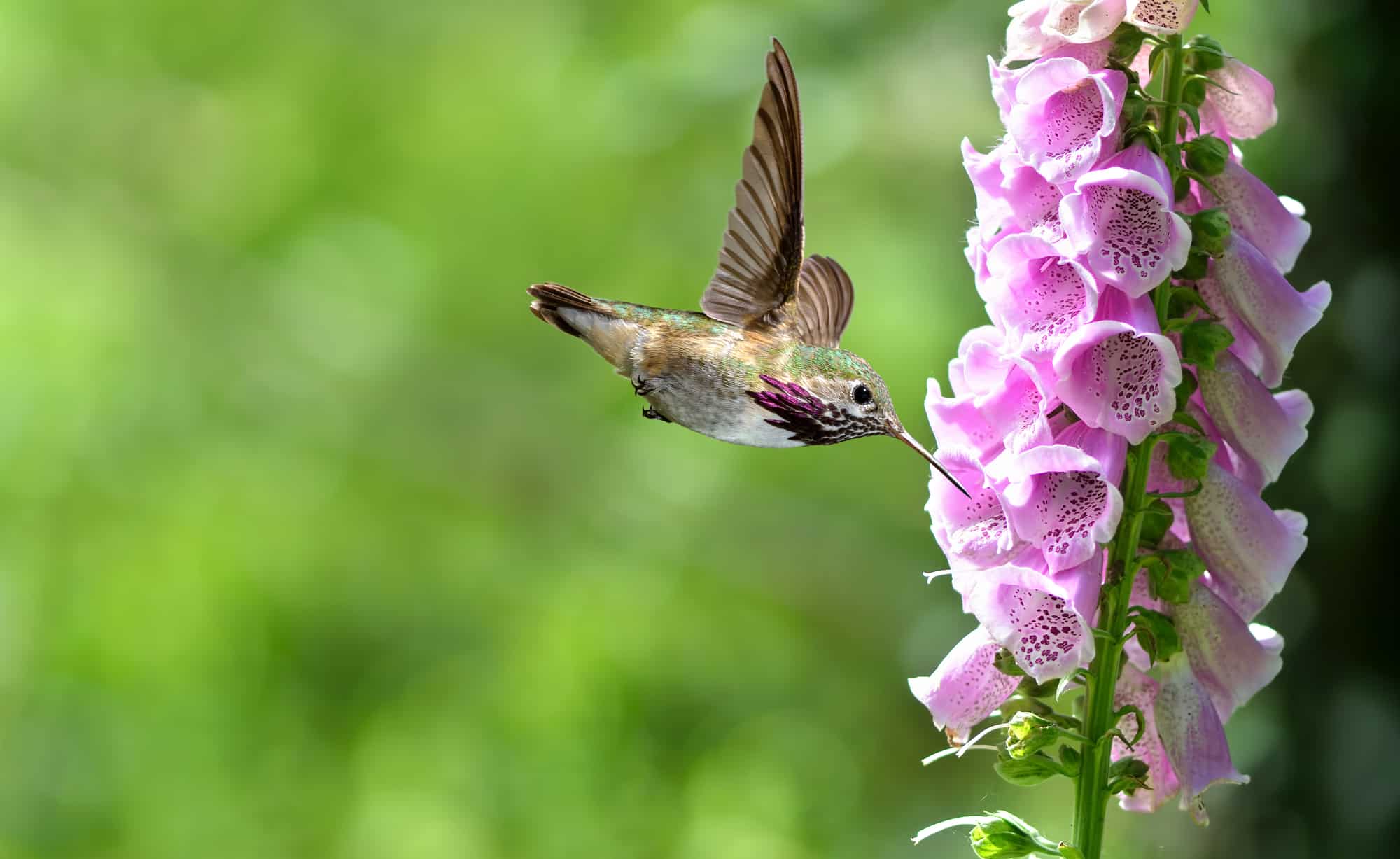Foxglove plants are among the top flowers for hummingbirds, and the relationship between these pollinating birds and these tubular flowering plants is fascinating.
There are about 20 species of foxglove, including the common or purple foxglove, a species native to Europe. It’s a biennial plant that does not flower in year one, but in year two, it produces tall flower spikes with wide, downward-facing purple flowers.
Foxglove has been introduced to the Americas, where it has become a popular flower in gardens and an interesting study in nature.
Evolution in the Americas
According to a study in the Journal of Ecology from the British Ecological Society, common foxglove brought to the Americas has evolved to accommodate pollination by hummingbirds.
Researchers from the University of Sussex in the United Kingdom, Colombia’s Universidad de Los Andes, and Costa Rica’s Universidad de Costa Rica, found that foxglove flowers in the Americas had a base of the cone structure 13 to 26 percent longer than those in the UK.
Since there are no hummingbirds in Europe, foxglove plants in the UK are pollinated only by bees, while both bees and hummingbirds pollinate the plants in the Americas.
Dr. Maria Clara Castellanos, an author of the study from the University of Sussex, said that long corollas may help improve the efficiency of pollen transfer and exclude less effective pollinators.
Researchers added that the transition was very quick, occurring over about 85 generations of plants since foxgloves’ introduction to the Americas in the 19th century.
The researchers state that their study doesn’t inconclusively prove that the changes were because of hummingbirds, but future studies are in the works to further examine this interesting relationship.
Foxglove for Gardens and Hummingbirds
While foxglove plants don’t flower in their first year, those flower spikes in year two create beautiful flowers and add some layering to your flower garden. They also provide a great food source for pollinators like hummingbirds and bees.
According to the University of Wisconsin-Madison, each plant produces between 1 and 2 million seeds that frequently self-seed.
UW-Madison suggests planting in full sun or light shade and states that foxglove can grow in almost any soil that is not too wet or dry. So, it sports beautiful flowers, it’s not too difficult to grow, and it’s a favorite of hummingbirds. What’s not to like?
First, know that foxglove can be toxic if ingested by humans or pets. And since it’s not native, it won’t support the diversity of life that native plants would. So, before you run out and plant foxglove in your backyard flower garden, consider some great native alternatives.
Native Plants and Why They Matter
The core of every local ecosystem is its plants. They’re where the food web starts, and without them, the ecosystem may have trouble reaching its full, ecologically diverse potential.
According to Entomologist Doug Tallamy, insects can only eat plants that they co-evolved with over thousands of years, and 96 percent of terrestrial birds rear their young on insects, Tallamy says.
The National Audubon Society reports that Tallamy’s research also shows that native oak trees support over 500 species of caterpillars, while non-native ginkgo trees support just five, adding that it takes about 6,000 caterpillars to raise one brood of chickadees.
So, while hummingbirds do like foxglove, you can do more for a whole backyard ecosystem by planting native plants like honeysuckle, cardinal flowers, trumpet plants, and others.

Although they’re far from the only native species to consider planting to support hummingbirds, the United States Department of Agriculture’s guide to attracting hummingbirds to your garden with native plants suggests the following plants, changing slightly by region:
- Red cardinal flower
- Trumpet honeysuckle
- Fireweed
- Mountain larkspur
- Hummingbird trumpet
- Manzanita
- Bearded penstemon
- Ocotillo
- Golden currant
- Wild bergamot
- Scarlet gilia
- Scarlet hedgehog cactus
- Western columbine
- Columbia lily
Frequently Asked Questions
Is Foxglove Poisonous?
Ingestion of the foxglove plant is poisonous to humans and dogs since it contains cardiac glycosides.
In pets, it can lead to nausea, vomiting, an irregular slow pulse, bloody diarrhea, and possible convulsions, according to the American College of Veterinary Pharmacists.
The ACVP does state that poisonings are rare because the plant is unpalatable, but accidental flower ingestion or drinking from a vase does occur.
The plant leaves can also irritate sensitive skin, according to the University of Wisconsin-Madison.
How Many Types of Foxglove Are There?
There are about 20 species of foxglove in the Digitalis genus, the most familiar of which is the purple or common foxglove (Digitalis purpurea).
There are many hybrids out there in an array of colors, however, including, red, pink, and white flowers. According to the Garden Lovers Club, there are 117 different varieties of foxglove.

